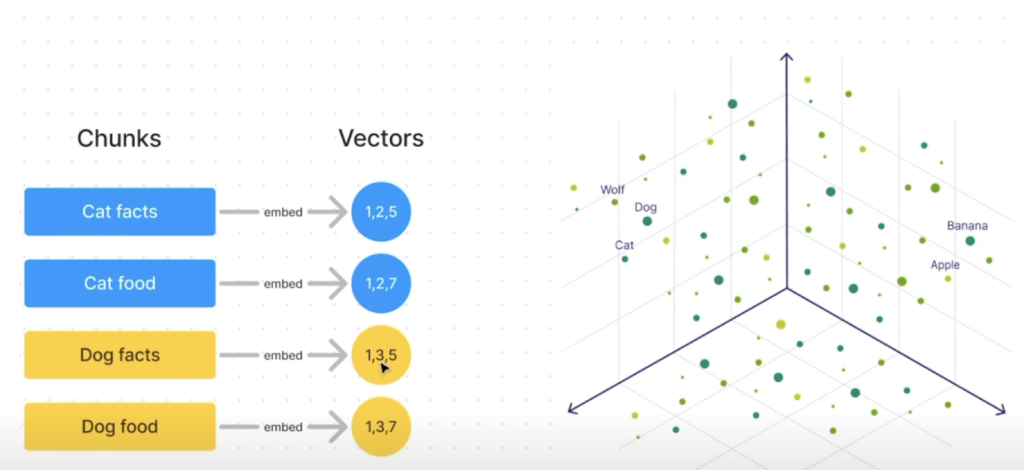What are Vector databases and how they help build better AI assistants

In today’s data-driven world, language models have emerged as a game-changer, revolutionizing how we interact with information. But what truly propels these marvels is the seamless integration of vector databases – a technological cornerstone that unlocks unprecedented potential.
Picture this: you’re building an AI-powered financial assistant to guide clients through the intricate world of investment.
Naturally, you want the assistant to draw from a vast repository of data, ensuring accurate and up-to-date insights. This is where vector databases shine, transforming how information is stored, retrieved, and harnessed.
Capturing Meaning in Numerical Vectors
At their core, vector databases store textual data as numerical vectors, each representing the essence of a word or phrase.

It’s akin to translating language into a mathematical language computers can comprehend. By capturing semantic relationships, these vectors enable language models to grasp context and deliver relevant responses tailored to your needs.
Imagine a world where your AI companion truly understands the nuances of your queries, responding with pinpoint precision and profound insights.
This is the power of vector databases – a bridge between the realms of human language and artificial intelligence.
Elevating Language Model Performance
Traditional databases, while reliable, often fall short when handling complex queries or unstructured data. This is where vector databases shine, seamlessly integrating with language models to deliver unparalleled capabilities.
Enhancing Accuracy and Relevance
By leveraging vector embeddings, language models can dynamically retrieve the most pertinent information from your proprietary data sources. This means no more relying solely on predetermined contexts or limited knowledge bases. Your AI assistant can now offer tailored advice, drawing from a vast pool of information curated specifically for your needs.
Powering Dynamic Interactions
Imagine engaging with a customer service chatbot that truly understands the nuances of your inquiry. Thanks to vector databases, the chatbot can analyze your question, match it with relevant vectors, and populate its context with the most appropriate information. The result? Seamless, contextually-aware conversations that leave you feeling genuinely understood and assisted.
Elevating Enterprise-Grade Applications
From e-commerce search engines to SQL code generation tools, vector databases are transforming how we interact with information across industries. These cutting-edge technologies enable language models to grasp the semantic meaning of queries, delivering highly relevant search results or generating SQL code that accurately reflects your needs.
The Vector Database Landscape
As with any emerging technology, the vector database arena is teeming with options, each catering to unique use cases and requirements. Let’s explore a few standout contenders:
- Pinecone: A dedicated vector database tailored for storing and retrieving embeddings, offering scalability and performance optimized for machine learning applications.
- FAISS: A library for efficient similarity search and clustering of dense vectors, developed by Meta AI Research. Its file-based approach makes it ideal for smaller datasets with high-performance demands.
- Redis: The popular in-memory data structure store now offers vector indexing, combining speed and efficiency with the power of vector embeddings.
- Elasticsearch: This full-text search powerhouse has embraced vector indexing, merging its robust capabilities with the ability to handle high-dimensional vector data.
- PostgreSQL with PGVector: The adaptability of this database management stalwart is further amplified with vector indexing capabilities, enabling seamless integration with your existing PostgreSQL infrastructure.
Each option presents its own strengths and trade-offs, catering to diverse requirements ranging from scalability and performance to familiarity and ease of integration.
Unlocking Limitless Possibilities
As language models continue to evolve, their integration with vector databases promises to redefine how we interact with information.
From personalized digital assistants to intelligent search engines and beyond, the synergy between these technologies opens up a world of possibilities.
Imagine an AI-powered writing companion that not only understands the context of your work but can also suggest relevant research materials, ideas, and insights tailored to your specific needs.
Or envision a medical diagnostic tool that can draw from a vast corpus of medical literature, delivering accurate diagnoses and treatment recommendations based on your unique symptoms and medical history.
The potential applications are as vast as the human imagination, and the journey has only just begun.
FAQs
What is the difference between a vector database and a traditional database? Traditional databases store structured data, while vector databases specialize in storing and retrieving high-dimensional vector embeddings, enabling efficient similarity search and semantic understanding.
Can vector databases be used with any language model? Yes, vector databases can be integrated with various language models, providing a robust infrastructure for storing and retrieving relevant information based on the model’s queries.
What are the advantages of using a vector database over a traditional database for language model applications? Vector databases are optimized for handling high-dimensional data, enabling language models to understand semantic relationships and deliver more accurate, contextually relevant responses.
How do I choose the right vector database for my application? The choice depends on factors such as scalability requirements, performance needs, existing infrastructure, and ease of integration. Dedicated vector databases like Pinecone excel at handling large-scale machine learning applications, while libraries like FAISS or extensions for traditional databases may be more suitable for smaller datasets or existing infrastructure.
Can I integrate a vector database with my existing language model application? Absolutely! Vector databases are designed to seamlessly integrate with language model applications, enhancing their capabilities and enabling dynamic, contextually-aware interactions.
Embracing the Future of Information Interaction
As you embark on your journey into the realm of language models and vector databases, remember: you are at the forefront of a technological revolution. Embrace the power of these technologies, and let your imagination soar.
Whether you’re building a groundbreaking AI assistant, revolutionizing search experiences, or unlocking new realms of knowledge, vector databases are the key to elevating your language model applications to unprecedented heights.
So, forge ahead, experiment, and push boundaries – for in the fusion of human ingenuity and artificial intelligence lies a future where information truly comes alive.